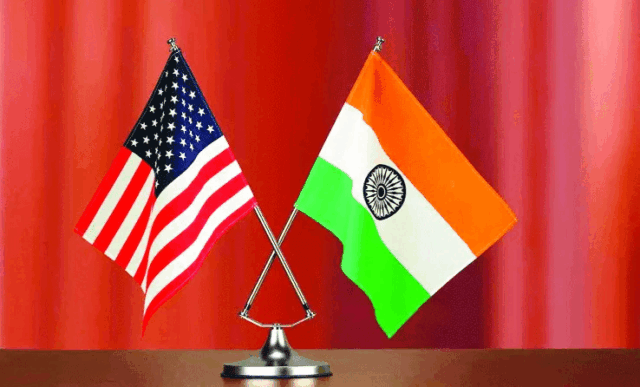New Delhi, August 05: India’s oil diplomacy has once again drawn the ire of Donald Trump, the unpredictable U.S. President who has returned to the White House with a vengeance. Trump, in a post on Truth Social, accused India of not only purchasing “massive amounts of Russian oil” but also reselling it for “big profits.”
He warned that, because of this, he would be “substantially raising the Tariff paid by India to the USA.” Already, the US has declared it will impose a 25 per cent tariff on Indian goods. This latest salvo is not just a trade policy signal; it is a political broadside with undertones of pressure and punishment. Yet, New Delhi’s reaction has been swift, cool and unapologetic.
In its first official response, the Ministry of External Affairs (MEA) issued a statement rejecting the accusations and reminding the world of a crucial truth: the United States itself had encouraged India’s Russian oil imports at the onset of the Ukraine war. The statement minced no words: “India has been targeted by the United States and the European Union for importing oil from Russia after the commencement of the Ukraine conflict.
In fact, India began importing from Russia because traditional supplies were diverted to Europe after the outbreak of the conflict. The United States at that time actively encouraged such imports by India for strengthening global energy markets stability.” The reminder is a factual reproof to Washington’s current posturing. It also reflects India’s growing confidence in standing its ground, especially when it comes to protecting its energy security and economic interests.
The MEA went further, exposing the double standards of both the U.S. and the EU. While India is being vilified for continuing oil trade with Russia, the EU in 2024 conducted over €67.5 billion worth of goods trade and €17.2 billion in services with Moscow.
Notably, European LNG imports from Russia hit a record 16.5 million tonnes, even after the invasion of Ukraine. The U.S., for its part, still imports uranium hexafluoride, palladium, and fertilisers from Russia, products critical to its nuclear and EV sectors. This isn’t a case of moral outrage; it’s selective outrage. And India knows it.
For the world’s third-largest oil importer, purchasing discounted Russian crude was not a geopolitical manoeuvre but an economic imperative. With traditional suppliers shifting supplies to Europe and prices surging post-Ukraine invasion, India found itself compelled to look east. The results are clear: Russian oil now accounts for nearly 30 to 35 % of India’s imports, up from nearly 3 % before the war. As the MEA stated, “India’s imports are meant to ensure predictable and affordable energy costs to the Indian consumer. They are a necessity compelled by global market situation.”
Trump’s rhetoric against India may seem new in tone, but it is familiar in form. US president has long viewed trade balances as zero-sum battles. India, with which the U.S. runs a trade deficit, is an easy target for his economic nationalism. He has repeatedly accused India of “high tariffs” and “non-monetary trade barriers,” conveniently ignoring the fact that U.S.-India trade has grown steadily and mutually over the past decade.
Now, with his frustration growing over Russia’s refusal to agree to a ceasefire in Ukraine, Trump seems to be turning his guns on Moscow’s partners. His hard words that India and Russia could “take their dead economies down together” betrays both his misunderstanding of India’s economic resilience and his habit of weaponising tariffs to pursue political ends.
India has neither backed down nor escalated. To its credit, India has calmly highlighted that trade and energy decisions are driven by national interest, not ideological alignment. Prime Minister Narendra Modi was last week in Varanasi. There in his public address stated that “India must remain alert to its own economic priorities.”
He called for a national movement to support locally made goods, a signal that India remains committed to self-reliance but not at the cost of pragmatism. Officials have reiterated that Indian oil companies will continue to buy from Russia based on commercial considerations. The government does not micromanage those decisions. And India is not alone: China and Turkey are also large buyers of Russian oil, yet they do not face the same intensity of public condemnation from Washington.
The future of U.S.-India ties
The bilateral relationship between India and the United States has grown quite significantly in the past two decades, from strategic convergence in the Indo-Pacific to deepening technological and defence ties. But Trump’s outbursts risk complicating that trajectory. His tariff threats, especially without specific details, could rattle investors and unsettle bilateral dialogue.
However, India has shown maturity. No knee-jerk reaction. India appears determined not to let short-term noise derail its long-term objectives. It has invested too deeply in economic modernisation and global partnerships to be bullied into abandoning strategic autonomy.
Moreover, Trump’s confrontational style may well backfire, and we have seen how he has swung like a pendulum in his decisions. How can he pressurise India on a matter where the U.S. itself has been complicit and continues to benefit? By his actions and words, Donald Trump risks pushing New Delhi closer to alternative trade and diplomatic forums, including BRICS+ and the Shanghai Cooperation Organisation.
India’s dignified but firm response to Trump’s threats marks a significant moment in its foreign policy evolution. Gone are the days when New Delhi would nervously recalibrate under U.S. pressure. Today, it articulates its national interest clearly, citing data, context, and a willingness to push back against unfair scrutiny.
As the MEA summed up: “The targeting of India is unjustified and unreasonable. Like any major economy, India will take all necessary measures to safeguard its national interests and economic security.” That is not defiance for its own sake. It is strategic maturity, and the world would do well to understand the difference.








